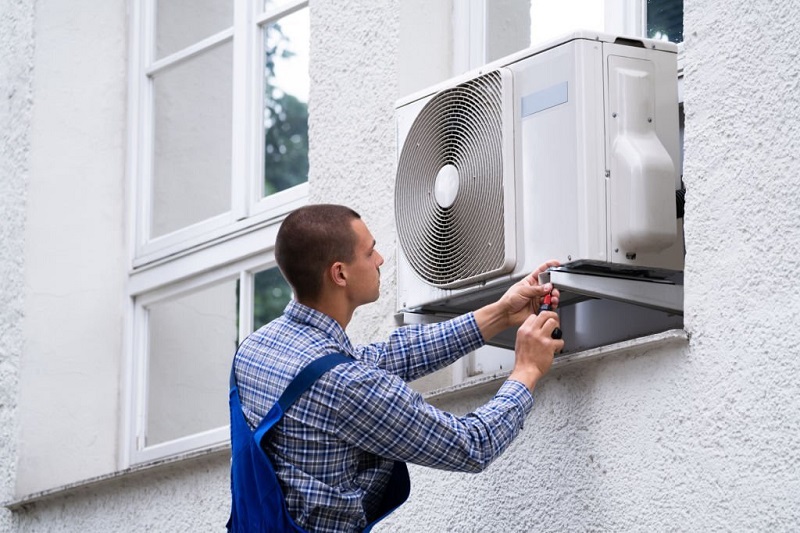Air conditioning installation is an essential part of creating a comfortable living or working environment. With the rising temperatures during summer months, having a reliable and efficient air conditioning system is not a luxury but a necessity. This comprehensive guide will discuss the different types of air conditioning systems, the installation process, and factors to consider when choosing the right air conditioning unit for your needs.
Whether you're a homeowner looking to upgrade your current AC system or a contractor seeking to provide the best air conditioning installation services, this article is for you.
 |
Air Conditioning Installation |
Types of Air Conditioning Systems
Central Air Conditioning
Central air conditioning systems are a popular choice for many homeowners and businesses. They consist of an outdoor condenser unit and an indoor air handler, which work together to cool the entire building through a series of ducts and vents. Central air conditioning systems are known for their efficiency and ability to maintain a consistent temperature throughout the space.
Split Air Conditioning
Split air conditioning systems are an alternative to central air conditioning and consist of an outdoor condenser unit and one or more indoor air handlers. These systems are ideal for cooling individual rooms or specific areas of a building, as each indoor unit can be controlled separately. Split air conditioning systems are also more energy-efficient than central air conditioning systems, as they only cool the areas that are in use.
Ductless Air Conditioning
Ductless air conditioning systems, also known as mini-split systems, are similar to split air conditioning systems but do not require any ductwork. They consist of an outdoor condenser unit and one or more indoor air handlers, which are connected by refrigerant lines. Ductless air conditioning systems are an excellent option for homes or buildings without existing ductwork or for those looking to add air conditioning to specific rooms or areas.
The Air Conditioning Installation Process
Assessing Your Needs
Before you begin the air conditioning installation process, it's essential to assess your needs and determine which type of air conditioning system is best suited for your home or building. Consider factors such as the size of the space, the number of rooms, and the existing infrastructure (e.g., ductwork).
Choosing the Right Air Conditioning Unit
Once you've determined the type of air conditioning system you need, it's time to choose the right unit. Factors to consider when selecting an air conditioning unit include energy efficiency, cooling capacity, noise level, and cost. It's essential to choose a unit that is the appropriate size for your space, as an undersized unit will struggle to cool the area effectively, while an oversized unit will consume more energy than necessary.
Professional Installation vs. DIY
While some homeowners may be tempted to tackle air conditioning installation as a DIY project, it's highly recommended to hire a professional installer. Air conditioning systems are complex and require specialized knowledge and tools for proper installation. Additionally, improper installation can lead to decreased efficiency, reduced system lifespan, and even safety hazards.
Installation Timeline
The timeline for air conditioning installation will vary depending on the type of system being installed and the specific requirements of your home or building. In general, central air conditioning installation can take anywhere from a few days to a week, while split and ductless air conditioning systems can typically be installed in one to two days.
 |
| HVAC Professional |
Factors to Consider When Choosing an Air Conditioning Installer
When selecting an air conditioning installer, it's essential to consider factors such as experience, licensing, and reputation. Look for installers who have a proven track record of successful installations and who are licensed and insured. Additionally, seek out recommendations from friends, family, or online reviews to ensure you're choosing a reputable and reliable installer.
Air Conditioning Maintenance and Troubleshooting
Regular maintenance is crucial for keeping your air conditioning system running efficiently and prolonging its lifespan. Routine maintenance tasks include cleaning or replacing air filters, checking refrigerant levels, and cleaning the outdoor condenser unit. Additionally, it's essential to address any issues or problems with your air conditioning system as soon as they arise. Common air conditioning problems include reduced cooling capacity, strange noises, and leaks. If you're experiencing any of these issues, it's best to consult with a professional technician to diagnose and repair the problem.
Conclusion
Air conditioning installation is a critical aspect of maintaining a comfortable and energy-efficient living or working environment. By understanding the different types of air conditioning systems, the installation process, and factors to consider when choosing an installer, you can ensure a successful and long-lasting air conditioning installation. Remember to prioritize regular maintenance and address any issues promptly to keep your air conditioning system running smoothly for years to come.


No comments:
Post a Comment